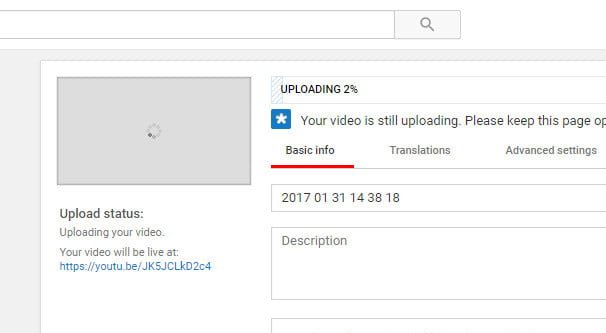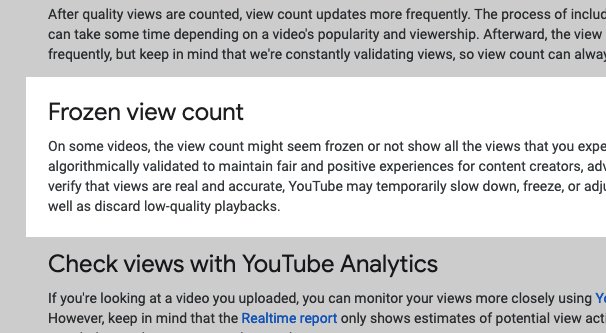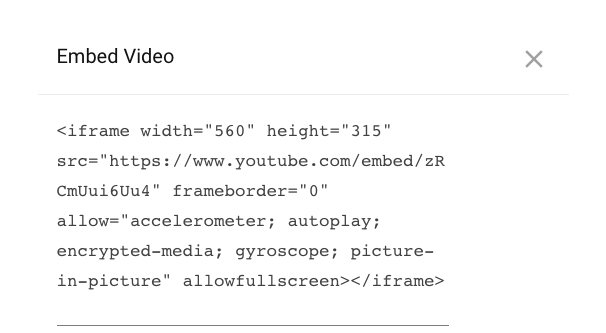 Written by ContentPowered.com
Written by ContentPowered.comView count on YouTube is important, though it’s not one of the metrics that actually matter for things like monetization. Think of it like social proof. A video with 100,000 views is going to naturally seem more compelling than one with 90,000.
What if those were both the same video, though? There’s a discrepancy between what you see on a video’s page and what you see in the YouTube Studio.
Studio Classic and Studio Beta
YouTube has been slowly rolling out the beta version of their new YouTube Studio. It’s a larger, more widescreen-friendly design, with less wasted space, and a more coherent design that meshes with other Google management properties, like Google Analytics or Google Ads.
Studio Beta is also a mess. It’s missing a lot of features that are available in Studio Classic, and which YouTube seems to be in no hurry to port over. For small-scale, casual YouTube creators, this isn’t a problem, since you probably weren’t using many of those features. For creators who are putting a lot of time and effort into their channels, this usually means something you were used to using is gone now.
You can still use the classic creator studio, but it’s a pain to have to click through to it every time you want to manage something on your channel, especially when there’s no reason to leave out some basic features.
Since we’re not really talking about the differences between the two platforms, I can say one thing is still the same: the back-end data. The like and comment counts, the view counts, and all of that information is the same regardless of which version of the creator studio you’re using.
Difference in View Counts
The difference in view counts is typically a discrepancy between a video page itself and that video’s data in the creator studio. For example, my test account has a video with over 80,000 views.
In the YouTube Creator Studio, the analytics tell me that the video has 81,959 views. On the video page itself, however, YouTube displays only 81,950 views. In the individual analytics for the video, it is rounded up to “82.0k” for the overview, but the actual chart shows 81,950.
Wow! A whole 9 views difference!
Most other videos on that channel range from under 100 views to around 1,000 views. Doing a quick comparison, most other videos on the channel have the same number of views between the two. It seems like only the high count videos are affected. Now, obviously, I don’t have a video with millions of views to compare. I would assume, however, that videos with millions of views will show larger discrepancies.
There are actually a lot of possible reasons why view counts may differ, so let’s talk about them all.
How YouTube Counts Views
The first thing you need to understand is what, specifically, counts as a view. YouTube does some vetting of views to make sure they’re valid. It’s why you can’t just hammer the F5 button on your own video pages to kick up a few thousand views and make your video start trending.
In order for a view to qualify, it needs to come from a real user. That user doesn’t need to have a YouTube account, but they do need to show the hallmarks of being a real user; that being valid activity and connection source, primarily. YouTube filters IP addresses of known botters, for example, and will look skeptically upon outdated user agents and nonsensical user information.
Views also need to last a certain amount of time before they count. This is to prevent rapid-fire refreshing counting as views. This has also been minimized somewhat since YouTube now remembers where you were in a video so you can resume where you left off if your browser closes or you refresh the page.
In other words, there are a lot of reasons why a view might be disqualified, and some of those are also reasons why the view count may be different between one page and another. Now let’s look at each reason in more detail.
Possibility 1: Your Own Views
The first cause of a view discrepancy is almost certainly what is happening in my case, with a meager 9 view difference between the video page and the studio page. In all likelihood, the studio page is counting my own views from times I’ve visited the page, to moderate comments or to check something about the video itself, while the video page is showing me the view count without my own views.
Why is this the case? I don’t know. YouTube has a strange idea of what should be valuable. The fact that my own views are even displayed at all is weird, but then, I suppose there’s no reason a creator wouldn’t want to watch their video at least once to make sure it works all the way through. YouTube processing occasionally does strange things to video or audio, and catching an encoding issue early is beneficial. Plus, a creator might want to show off their video to an audience; that view should count. Maybe it’s not so weird after all.
The fact that the number is different between the two displays is the really odd part, and it’s probably just to keep creators from inflating their public view counts early on, when a boost would matter. Fortunately, there are a lot of other ways to get a video those initial views, and they’re a lot easier than doing it yourself with your own account.
Possibility 2: Data Sampling
With trillions of videos being uploaded every second (a slight exaggeration) YouTube has to have an incredible infrastructure to handle serving all of that content. Something has to give, and they’re always looking for ways to lighten the load. If you came up with a way to dramatically compress, transmit, and decompress video faster than what YouTube already can, you could probably sell it to them for approximately infinite money.
One element that falls behind is accurate data. Just like Google Analytics, sampling gives you relatively accurate data, but specific numbers tend to take a hit. It’s entirely possible that the discrepancy in view counts comes from data sampling before that data is eventually verified.
Possibility 3: New, Unvetted Views
This third possibility is mostly relevant to new videos or videos that have an ongoing, evergreen audience. It’s less likely to be the case with my test video, for example. Basically, YouTube will vet views as they come in, but they’re not vetted quickly. They will show you a video in your Studio before they vet the view, and when they vet the view and find an issue with it, they will adjust the data accordingly.
This is also why videos might not show a new view right away, even when you know you’re watching the video on a new computer at a new location. YouTube has to vet the view to make sure it’s legit before they add it.
This is a result of ad adjustment in the system from how it used to work. In the past, any video under 300 views just counted views whenever someone watched it. Since a huge majority of videos on YouTube never get over 300 views, it didn’t matter. Those videos were rarely monetized and even when they were, they only earned a few cents at a time. It was no loss for YouTube to just let fake views fester. Then, when the video hit 300 or so, the view count would freeze. This put it in a queue for YouTube to audit the views, which would adjust the number.
Eventually, YouTube decided that their filtering algorithms could work better in real time, and the audit queue was removed. Now views simply don’t apply if they don’t pass vetting.
Possibility 4: Removed Views Still Counting
This one kind of piggybacks off the last, and can cause some discrepancy between what you see on a video page and what you see in your Studio page. Generally, it will show more on your video page than in your Studio, and the numbers will be adjusted quickly to match.
What happens is you essentially just visit your Studio and your video page in the middle of it being updated, and catch the numbers when they’re in the process of being removed. This is pretty rare, and if you refresh in half an hour or so and see the numbers match – with the lower number being accurate – this might be the cause.
Possibility 5: Frozen View Count
YouTube will occasionally freeze the view count of a video when they want to audit it. This is similar to the old 301+ video view count freeze mentioned above, except it’s not explicitly a set threshold and it isn’t announced. When your video views freeze, it’s generally on the video page, though it can also freeze your Studio analytics if the audit is going to take a while, usually with extremely popular videos.
To quote from Google directly:
“On some videos, the view count might seem frozen or not show all the views that you expect. Video views are algorithmically validated to maintain fair and positive experiences for content creators, advertisers, and users. To verify that views are real and accurate, YouTube may temporarily slow down, freeze, or adjust the view count, as well as discard low-quality playbacks.”
Possibility 6: Embedded Views
View counts can be weird with embedded videos. When a viewer watches a video from an embed, it may or may not count. A normal copy and paste of the embed code will work fine and will count a view normally.
A video that is embedded with autoplay enabled, however, generally does not count, unless the user takes an action that indicates that they were actually watching, such as liking the video or adjusting the volume or pausing and restarting it. This is because it was often abused with hidden embeds as a black hat technique.
Does a Discrepancy Matter?
At the end of the day, if you discover a discrepancy between the view count on your video and the view count in your analytics, does it really matter?
In my case, for example, it’s one view out of every 10,000, more or less, that is off. That’s still a very accurate view count, one way or the other. Do those nine views affect me in one direction or another? Not in the slightest. If they were monetized, it would be a completely minimal amount of money. Since they aren’t, it’s inconsequential.
For a video with tens or hundreds of millions of views, the number could be higher, and the discrepancy could matter more. On the other hand, with a video with millions of views, the discrepancy is changing at such a rapid pace that it’s more about trends and about broad strokes. If your view count is off by 10,000, it doesn’t really make a difference when you’re getting 150,000 new views every day. Sooner or later, the data will catch up.
What do you think? Have you experienced any significant discrepancy in view counts between Studio and other locations? If so, were you able to trace it to its source, or did you simply not care about it? I’d like to hear your stories, if you have any.









